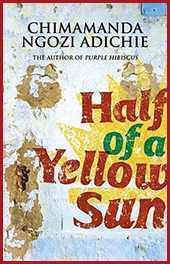Chimamanda Ngozi Adichie Fourth Estate, 2006, ISBN: 9780007200283
Chimamanda Ngozi Adichie’s Half of a Yellow Sun was, from memory, a very fashionable book to have read some years ago. It achieved great success worldwide, receiving the Orange Prize for Fiction in 2007 and many positive reviews. Set before and during the Nigerian Civil War, the novel examines colonial and post-colonial Nigerian politics, white attitudes towards black Africa, international reactions to the Civil War, nationalism and varying forms of hypocrisy, amongst other themes. Despite the sharpness of Adichie’s criticisms, though, the novel is easy to read and very accessible to those who, like me, have little background knowledge about Nigeria or the Igbo people.
The novel is told through the points of view of three interconnected characters. The first is Ugwu, a village boy who goes to work as houseboy for outspoken Igbo nationalist, Professor Odenigbo, in the university city of Nsukka. Though he expects hard work and harsh treatment, Ugwu is surprised when Odenigbo encourages him to study and to read. Through Ugwu we learn a little of rural Igbo culture and family structure, including superstitions when he suspects Odenigbo’s mother of using witchcraft to force Odenigbo away from his lover.
There is Olanna, the daughter of a high-ranking member of government, who upon returning from her studies in London decides to move in with Professor Odenigbo, who is her lover. Olanna’s life of high privilege does not protect her from experiencing the horrors of pre-war genocidal attacks against Igbo people in Nigeria’s north, or from the wartime privations which made the Civil War infamous. We watch Olanna’s and Professor Odenigbo, initially optimistic about the formation of the independent state of Biafra, transform as the war begins and wears on. While the nationalistic Professor fails to cope with the failure of his Biafran dream, Olanna is pragmatic once her shock passes, and focuses solely on survival for herself and her family.
Lastly we have Richard, an English writer who leaves his English girlfriend in favour of Olanna’s twin sister Kainene. I found Richard’s chapters the least compelling in the novel. Though his story is interesting, Richard’s purpose in the novel is to provide an outsider’s eye and a wider view of the events of the civil war through his discussions with other Nigerian-based foreigners, and his columns from within Biafra. Adichie is fiercely critical of international apathy to the plight of Biafran civilians during the war and Richard exists to expose this apathy. He is not, however, a particularly interesting character by himself.
The novel is in four parts. The first and third parts in the early 1960s; the second during increasing ethnic conflict between Hausa and Igbo people, then the formation of Biafra and the commencement of the war; and the fourth during the stalemate and blockade which eventually ended the war. Initially it seemed to me the novel was divided to create a sense of mystery about a conflict which arose between Olanna, Kainene, Richard and Onenigbo. Read in this way, the structure seems forced and artificial. However, I now believe Adichie’s intention was rather to break up the wartime storyline. Without this narrative break the novel would feel very bleak, as life in Biafra steadily worsens as bombing campaigns and food shortages become the norm.
Apart from my irritation with the structure, I found Half of a Yellow Sun an enlightening novel with interesting characters. I am keen to read Adichie’s other novels, Purple Hibiscus and Americanah. The edition I read, published in 2014, also included photographs taken in Biafran refugee camps and an essay by Adichie, In the Shadow of Biafra, on the continued legacy of the conflict in Nigeria and the experience of writing a novel about such a dark period of history.



Another fine review!
I wonder if a word or two could be missing from the sentence, “The structure of the novel, with the first and third parts in the early 1960s; the second during increasing ethnic conflict between Hausa and Igbo people, then the formation of Biafra and the commencement of the war; and the fourth during the stalemate and blockade which eventually ended the war”
Why is it called ‘Half of a Yellow Sun’?
Haha, thanks Andy, I’ll go and patch that up. I believe the title is a reference to the Biafran flag.
Aha!